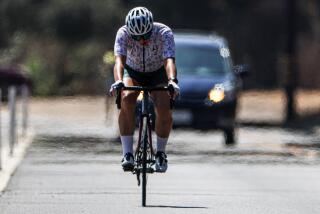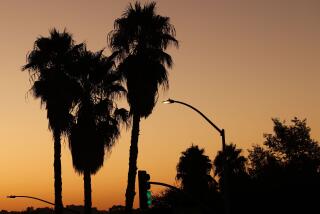County Cranks Up the Juice Under Withering Heat : Weather: Energy consumption set a record as temperatures throughout the area passed the century mark.
- Share via
A blistering heat wave--punctuated by record-high energy consumption and a brush fire that briefly closed busy Interstate 8 near Alpine--sent temperatures soaring throughout San Diego County for the second day in a row, producing a furnace-like 120 in Borrego Springs.
Compounding the heat was a sudden increase in dirty air, making Tuesday the smoggiest day of the year in the county.
Officials issued a heat advisory, warning people to use “common sense” for the next several days to avoid heat-related hazards.
“When it gets this hot, construction workers, roofers and other people who work outside need to take precautions, take a lot of breaks in the shade and drink plenty of water,” said National Weather Service forecaster Dan Atkin.
Motorists are urged to avoid driving in the desert or to take along extra water for drinking and for their vehicles’ radiators, he said.
In addition to the advisory for people, the weather service issued an agricultural heat advisory for inland San Diego County.
“The temperature will fluctuate some during the next several days before it cools off a little next week,” Atkin said.
The heat is expected to linger until the middle of next week.
Temperatures in many places in the county hovered near or above the century mark, including 111 in Santee, 110 at the San Diego Wild Animal Park near Escondido, 107 in Alpine and Spring Valley, 106 in Fallbrook, 104 in Lemon Grove, 102 in La Mesa and 105 in Poway, Ramona and El Cajon.
Few coastal communities were spared. San Diego, for example, tied the 14-year-old record for the date with a high of 94 at Lindbergh Field. Normal for the city this time of year is 73.
It was 93 in National City, 92 in Chula Vista, 89 in Coronado, and a relatively comfortable 80 in Del Mar and 72 at Oceanside Harbor.
Air conditioners have been running full tilt, driving electricity demand to a record high, said Fred Vaughn, a spokesman for San Diego Gas & Electric Co.
Peak consumption was 2,871 megawatts at 4 p.m., breaking the old record of 2,831 megawatts set Sept. 6, 1988, Vaughn said. One megawatt--or 1 million watts--is enough electricity to serve 1,000 households.
By purchasing energy from utilities in Los Angeles, San Francisco and other areas, SDG&E; has boosted its system capacity to 3,100 megawatts, which should prove sufficient if the heat wave continues, Vaughn said.
“We anticipate that demand will continue to be heavy, but we don’t envision any problem in meeting demand,” he said.
If energy consumption goes much higher, the company will ask its largest consumers to cut back usage and will ask that residential customers raise their air-conditioning thermostat to at least 78 degrees and use their ovens, washers, dryers and other major appliances at night or in the early morning, Vaughn said.
“Many people don’t realize that lowering their air conditioner by 2 degrees raises their utility bill by 5%,” he said. “That’s something for customers to think about.”
Five San Diego County communities had unhealthy air Tuesday as measured by the federal pollution standards index, and many others were close to that mark, said Tom Ryan, assistant meteorologist with the county Air Pollution Control District. Cities with unhealthful ratings were Escondido, El Cajon, Chula Vista, Kearny Mesa and Alpine.
Ryan said most of the pollution was blown south from Los Angeles. San Diego’s second-smoggiest day was June 2.
For firefighters, the heat was compounded by brush fires.
A brush fire temporarily closed I-8 between Los Coches and Tavern roads, from Lakeside to near Alpine, late Tuesday afternoon. The fire was set by an arsonist and is under investigation, fire officials said.
More than 330 firefighters from several area agencies assisted the California Department of Forestry in battling the fire, which started at 4:45 p.m. and knocked out electricity in the area, destroyed at least one house and burned more than 175 acres, a forestry official said.
Fire strike teams, with members from several area fire departments, had the blaze under control and were expecting to have it contained by midnight, officials said.
Another brush fire began at 4:30 p.m. east of Interstate 15 near Escondido and burned at least 38 acres. The fire was brought under control by 8 p.m. Officials said the fire was set by an arsonist.
No injuries were reported in either fire.
A 3-acre fire broke out in Julian on Old Julian Highway, said Dolores Fremter, a spokeswoman for the California Department of Forestry. Fremter did not know the cause of the blaze, but said there were no injuries and no loss of property.
Water use remains below normal but continues to rise as the warmer temperatures linger, water officials said. Since June 1, the city of San Diego has reduced its water use by 19%--well beyond its 10% goal for June through September--but the reduction rate dwindled from 17.8% Friday to 4.3% Monday, said Marsi Steirer, a water conservation analyst with the city Water Utilities Department. “We’ve seen some less savings in the past few days, but we’re hoping to reach that 10% overall goal by the end of the summer.
“There’s a definite correlation between the temperature and rainfall and the actual water savings, but remember, there are a lot of fluctuations in the day-to-day numbers, so don’t read too much into a few days,” she said.
Hospital officials reported a slight increase in people seeking medical help for heat-related health problems.
Children and the elderly with existing health problems are more susceptible to the heat, said Dr. Thomas Kravis of Mercy Hospital.
“The symptoms range from confusion and weakness all the way to heat stroke, where a person has seizures and can die,” Kravis said.
Medical authorities recommend avoiding outdoor exercise and alcohol during the hottest hours, drinking plenty of cool water, wearing loose cotton clothes and staying in air-conditioned or ventilated areas.
Pets also need protection from the sun, especially elderly and sick animals, local veterinarians said.
“We see a lot of dogs each summer suffering from heat problems after being left too long in cars or other overheated places,” said Al Guajardo, a technician at Colina Veterinary Hospital.
Despite the heat, area highways have not been burdened with overheated vehicles in the past two days, a California Highway Patrol spokeswoman said.
The forecast for San Diego calls for continued hot temperatures in the deserts, ranging to 120 degrees. Temperatures at the beaches and on the coastal strip are expected to range from highs of 76 to 88 to a low of 68.
Inland it will remain hot, with highs in the valleys reaching 112. Overnight lows, however, are expected to dip into the mid-60s.
More to Read
Sign up for Essential California
The most important California stories and recommendations in your inbox every morning.
You may occasionally receive promotional content from the Los Angeles Times.













